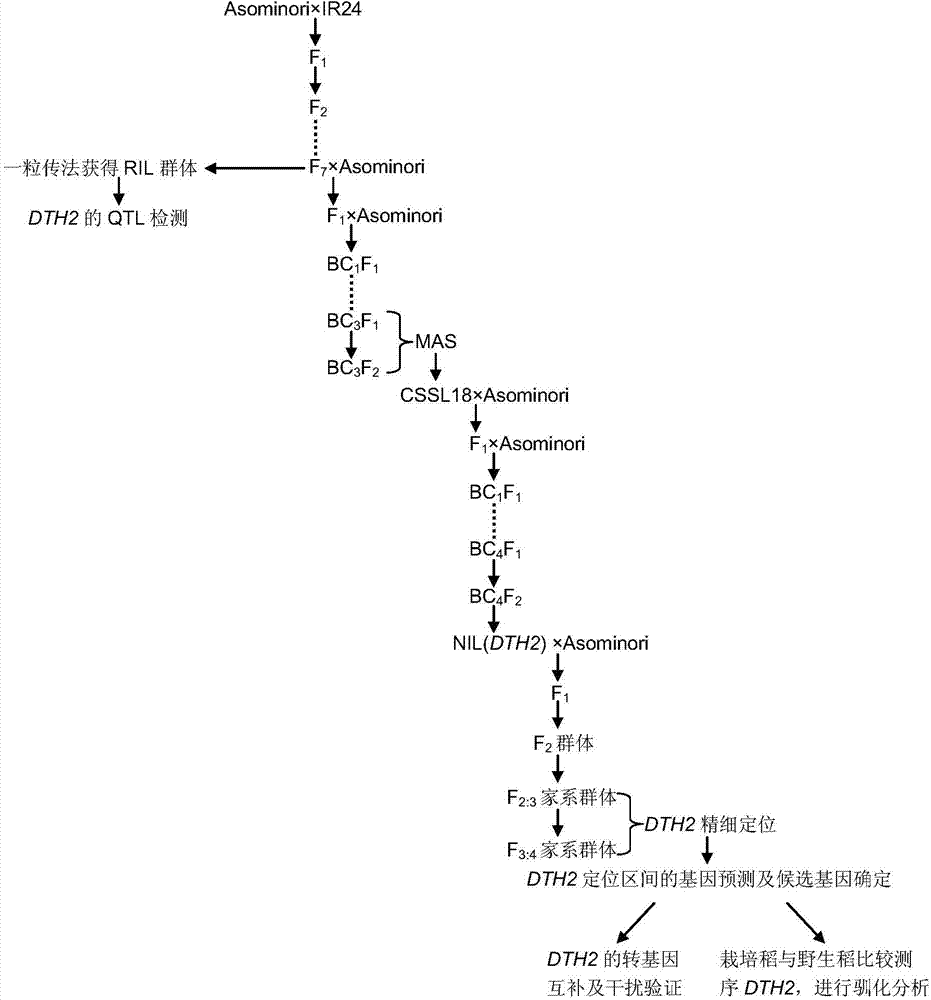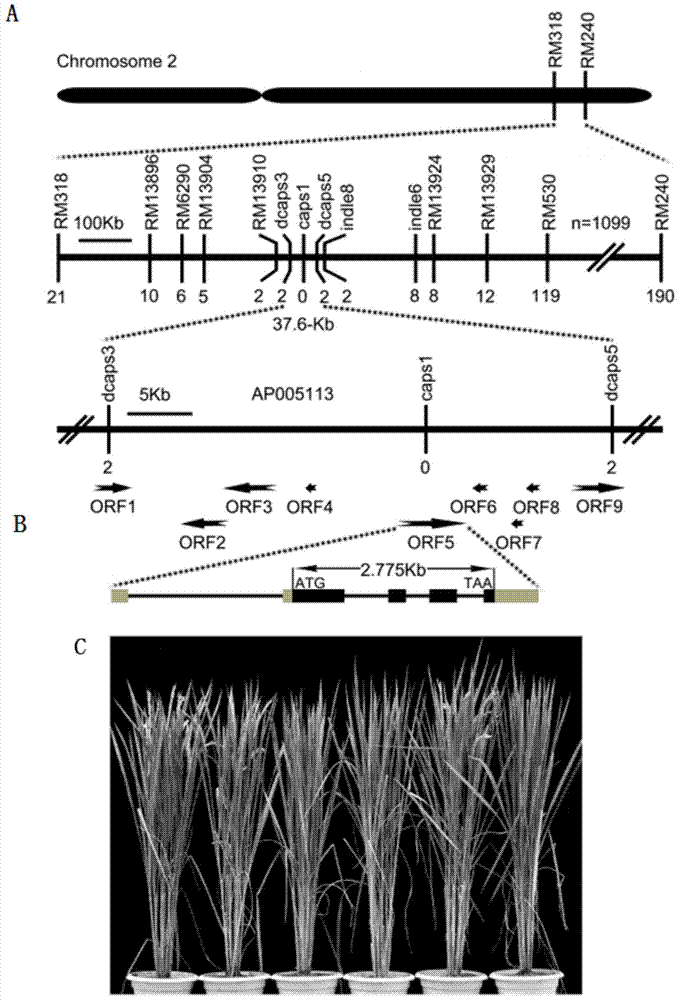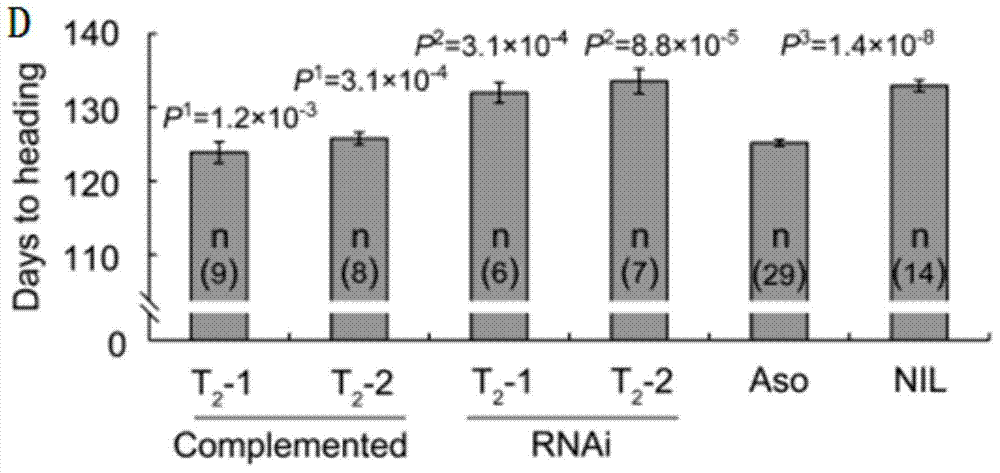Group of genes DTH2 for controlling rice heading period and haplotype and application of genes DTH2
A technology of haplotype and heading stage, applied in the field of genetic engineering
- Summary
- Abstract
- Description
- Claims
- Application Information
AI Technical Summary
Problems solved by technology
Method used
Image
Examples
Embodiment 1D
[0031] The construction of embodiment 1DTH2 nearly isogenic line
[0032] 1. QTL detection, backcross and selection of DTH2
[0033] Using the RILs population of Asominori and IR24, our previous study detected multiple loci controlling heading date, one of which, DTH2, contained DTH2-a under natural long-day (NLD) conditions plants heading earlier than plants containing DTH2-i. Using the CSSLs population with Asominori as the background parent and IR24 as the donor parent, we found that CSSL18 has a significantly delayed maturation and stable expression compared with the background parent Asominori, because CSSL18 only inserts IR24 in some fragments compared with the background parent Asominori Therefore, the inserted indica fragment IR24 is the root cause of the extremely late maturity of CSSL18. We crossed CSSL18 with Asominori once, backcrossed 4 times consecutively, and then selfed to construct a CSSL18 / Asominori BC containing 374 individuals 4 f 2 population, from whi...
Embodiment 2
[0039] Fine positioning and map-based cloning of embodiment 2 DTH2
[0040] 1. Identification of heading date phenotypes of two parents
[0041] Heading date refers to the date when the first ear of a single plant is pulled out; days of heading date refers to the number of days from sowing to the first ear of a single plant; extreme late heading single plant refers to the same or later heading date than the parent NIL (DTH2) Single plant; extremely late heading family refers to a family in which most of the individual plants heading in a random family are the same or later than the parent NIL (DTH2). Under NLD conditions in Beijing (Dongmen Net Room, Institute of Crop Science, Chinese Academy of Agricultural Sciences), NIL(DTH2) headed 7.4 days later than Asominori (Table 1, figure 2 C). However, under natural short-day (NSD) conditions in Hainan (Southern Propagation Base of Nanjing Agricultural University in Lingshui, Hainan), there was no significant difference in earing...
Embodiment 3
[0050] Transgenic functional complementation experiment of embodiment 3DTH2
[0051] 1. Construction of genome full-length complementary vector
[0052] According to the predicted candidate gene sequence, using Nipponbare (English name Nipponbare, a rice variety with complete genome sequencing) sequence as a template, primers were designed to sequence the DTH2 genome from Asominori, and it was found that their sequences were consistent in this segment . Then, using the Nipponbare BAC clone OsJNBa33B21 (purchased from the National Gene Research Center of the Chinese Academy of Sciences) as a template, the whole genome of DTH2 was amplified (see Table 4 for primers) to obtain a 7867bp DNA fragment. This fragment was recombined into pCAMBIA1305.1 (a publicly reported and used plasmid from Australia, image 3 ) SmaI (purchased from Fermentas, Canada) site.
[0053] 2. Agrobacterium-mediated genetic transformation of rice
[0054] The obtained recombinant plasmid with correct s...
PUM
 Login to View More
Login to View More Abstract
Description
Claims
Application Information
 Login to View More
Login to View More - R&D Engineer
- R&D Manager
- IP Professional
- Industry Leading Data Capabilities
- Powerful AI technology
- Patent DNA Extraction
Browse by: Latest US Patents, China's latest patents, Technical Efficacy Thesaurus, Application Domain, Technology Topic, Popular Technical Reports.
© 2024 PatSnap. All rights reserved.Legal|Privacy policy|Modern Slavery Act Transparency Statement|Sitemap|About US| Contact US: help@patsnap.com










